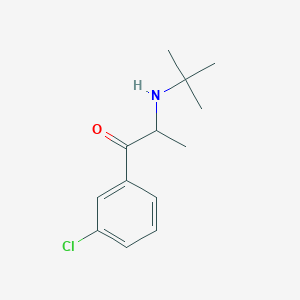Drug Information
| General Information | ||||||
|---|---|---|---|---|---|---|
| Drug ID |
DR00836
|
|||||
| Drug Name |
Bupropion
|
|||||
| Synonyms |
Amfebutamon; (+-)-1-(3-chlorophenyl)-2-((1,1-dimethylethyl)amino)-1-propanone; (+-)-Bupropion; (-)-2-(tert-Butylamino)-3'-chloropropiophenone; (-)-2-(tert-Butylamino)-3'-chlorpropiophenon; 1-(3-chlorophenyl)-2-[(1,1-dimethylethyl)amino]propan-1-one; 1-Propanone; 2-(Tert-Butylamino)-3'-chloropropiophenone; 2-(tert-butylamino)-1-(3-chlorophenyl)propan-1-one; 34841-39-9; 34911-55-2; AMFEBUTAMONE HCl; Alpha-(tert-Butylamino)-m-chloropropiophenone; Alpha-(tert-butylamino)-m-chloropropiophenone; Amfebutamon; Amfebutamona; Amfebutamona [INN-Spanish]; Amfebutamone; Amfebutamonum; Amfebutamonum [INN-Latin]; BRN 2101062; Bupropion (INN); Bupropion (Old RN); Bupropion (USAN); Bupropion Hcl; Bupropion SR; Bupropion [INN:BAN]; Bupropion hydrocloride; CHEBI:3219; CHEMBL894; Elont; Elontril; SNPPWIUOZRMYNY-UHFFFAOYSA-N; Wellbatrin; Zyban; alpha-(tert-butylamino)-m-chloropropiophenone; amfebutamonum; bupropion
|
|||||
| Drug Type |
Small molecular drug
|
|||||
| Indication | Smoking cessation [ICD11: 6C4A.2] | Approved | [1] | |||
| Structure |
|
 |
||||
| 3D MOL | 2D MOL | |||||
| Formula |
C13H18ClNO
|
|||||
| Canonical SMILES |
CC(C(=O)C1=CC(=CC=C1)Cl)NC(C)(C)C
|
|||||
| InChI |
InChI=1S/C13H18ClNO/c1-9(15-13(2,3)4)12(16)10-6-5-7-11(14)8-10/h5-9,15H,1-4H3
|
|||||
| InChIKey |
SNPPWIUOZRMYNY-UHFFFAOYSA-N
|
|||||
| CAS Number |
CAS 34841-39-9
|
|||||
| Pharmaceutical Properties | Molecular Weight | 239.74 | Topological Polar Surface Area | 29.1 | ||
| Heavy Atom Count | 16 | Rotatable Bond Count | 4 | |||
| Hydrogen Bond Donor Count | 1 | Hydrogen Bond Acceptor Count | 2 | |||
| XLogP |
3.2
|
|||||
| PubChem CID | ||||||
| ChEBI ID |
ChEBI:3219
|
|||||
| TTD Drug ID | ||||||
| DT(s) Transporting This Drug | BCRP | Transporter Info | Breast cancer resistance protein | Substrate | [2] | |
| P-GP | Transporter Info | P-glycoprotein 1 | Substrate | [3] | ||
| References | ||||||
| 1 | Bupropion was approved by FDA. The official website of the U.S. Food and Drug Administration. (2019) | |||||
| 2 | Role of transporter-mediated efflux in the placental biodisposition of bupropion and its metabolite, OH-bupropion. Biochem Pharmacol. 2010 Oct 1;80(7):1080-6. | |||||
| 3 | Sertraline and its metabolite desmethylsertraline, but not bupropion or its three major metabolites, have high affinity for P-glycoprotein. Biol Pharm Bull. 2008 Feb;31(2):231-4. | |||||
If you find any error in data or bug in web service, please kindly report it to Dr. Yin and Dr. Li.
